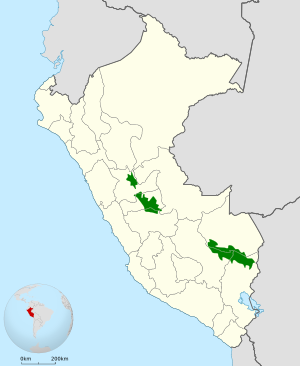Peruvian piedtail facts for kids
Quick facts for kids Peruvian piedtail |
|
|---|---|
| Conservation status | |
| Scientific classification | |
| Genus: |
Phlogophilus
|
| Species: |
harterti
|
 |
|
The Peruvian piedtail (Phlogophilus harterti), also known as the Colibrí Colipinto Peruano in its home country, is a tiny and colorful hummingbird. It belongs to a group of hummingbirds called "coquettes." This special bird lives only in Peru, which means it is endemic there.
Contents
About the Peruvian Piedtail
The Peruvian piedtail is a unique type of hummingbird. It shares its family group, called a genus, with only one other bird: the Ecuadorian piedtail. This means these two birds are very closely related!
What Does It Look Like?
The Peruvian piedtail is a small bird, about 7.2 to 7.5 cm (2.8 to 3.0 in) long. That's about the length of your finger! It weighs only 2.2 to 2.7 g (0.078 to 0.095 oz), which is lighter than a penny.
Both male and female Peruvian piedtails look alike. They have a short, straight, black beak. Their backs and the top of their heads are a bright green color. You can spot a small white patch right behind each of their eyes.
Their throats and the middle of their chests and bellies are white. The rest of their undersides are a soft, light brown color. The two tail feathers closest to their body are green with a wide black tip. All the other tail feathers are light brown with a wide black stripe across them. Young Peruvian piedtails look very similar to the adults, but the feathers on their heads and necks have light brown edges.
Where Does It Live?
The Peruvian piedtail lives in central and southeastern Peru. It doesn't live everywhere in Peru, but in specific, separated areas. You can find it in the eastern Andean foothills, which are the lower parts of the Andes mountains. These areas are in the Huánuco, Pasco, Cuzco, and Puno departments of Peru.
This hummingbird prefers to live inside both old, untouched forests and newer forests that have grown back. It is most commonly found at an elevation of about 1,000 m (3,300 ft) above sea level. However, it can live anywhere between 750 and 1,500 m (2,500 and 4,900 ft) high in the mountains.
Peruvian Piedtail Behavior
How It Moves Around
The Peruvian piedtail usually stays in one area and doesn't travel far. However, scientists believe that sometimes these birds might move up or down the mountains depending on the season or food availability.
What It Eats
Like many hummingbirds, the Peruvian piedtail loves to drink nectar from flowers. It will perch on a branch to reach the flowers. It also eats tiny insects. It finds these insects by picking them off leaves and other plants.
Reproduction and Life Cycle
Not much is known about how the Peruvian piedtail builds its nests or raises its young. Scientists are still learning about its breeding habits and life cycle.
Its Song
The Peruvian piedtail has a distinct song. It's described as a "shrill, thin series of notes." The notes start high and then get lower in pitch, sounding like 'SIIII siii suuu'.
Conservation Status
The IUCN (International Union for Conservation of Nature) has evaluated the Peruvian piedtail's status. They have listed it as "least concern." This means that, for now, there are enough of these birds, and they are not considered to be in immediate danger of disappearing.
Even though its habitat is mostly healthy, there are some threats. Logging, which is cutting down trees, and turning forest land into farms can harm their homes. However, the Peruvian piedtail is quite adaptable. It can live in areas where humans have changed the habitat, as long as there are still patches of forest and new growth for them to live in.
See also
 In Spanish: Colibrí Colipinto Peruano para niños
In Spanish: Colibrí Colipinto Peruano para niños


